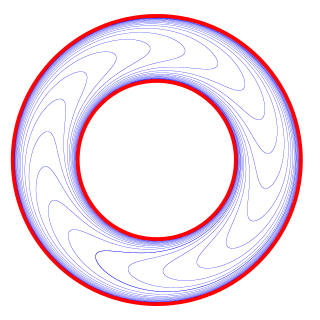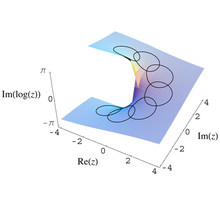In the mathematical field of algebraic topology, the fundamental group of a topological space is the group of the equivalence classes under homotopy of the loops contained in the space. It records information about the basic shape, or holes, of the topological space. The fundamental group is the first and simplest homotopy group. The fundamental group is a homotopy invariant—topological spaces that are homotopy equivalent have isomorphic fundamental groups. The fundamental group of a topological space is denoted by .
In mathematics, especially in category theory and homotopy theory, a groupoid generalises the notion of group in several equivalent ways. A groupoid can be seen as a:
A covering of a topological space is a continuous map with special properties.
In the mathematical disciplines of topology and geometry, an orbifold is a generalization of a manifold. Roughly speaking, an orbifold is a topological space which is locally a finite group quotient of a Euclidean space.
In mathematics, a Lie algebroid is a vector bundle together with a Lie bracket on its space of sections and a vector bundle morphism , satisfying a Leibniz rule. A Lie algebroid can thus be thought of as a "many-object generalisation" of a Lie algebra.
In mathematics, a Lie groupoid is a groupoid where the set of objects and the set of morphisms are both manifolds, all the category operations are smooth, and the source and target operations

In mathematics, a foliation is an equivalence relation on an n-manifold, the equivalence classes being connected, injectively immersed submanifolds, all of the same dimension p, modeled on the decomposition of the real coordinate space Rn into the cosets x + Rp of the standardly embedded subspace Rp. The equivalence classes are called the leaves of the foliation. If the manifold and/or the submanifolds are required to have a piecewise-linear, differentiable, or analytic structure then one defines piecewise-linear, differentiable, or analytic foliations, respectively. In the most important case of differentiable foliation of class Cr it is usually understood that r ≥ 1. The number p is called the dimension of the foliation and q = n − p is called its codimension.
In the mathematical field of complex analysis, a branch point of a multi-valued function is a point such that if the function is n-valued at that point, all of its neighborhoods contain a point that has more than n values. Multi-valued functions are rigorously studied using Riemann surfaces, and the formal definition of branch points employs this concept.
In geometric topology, a field within mathematics, the obstruction to a homotopy equivalence of finite CW-complexes being a simple homotopy equivalence is its Whitehead torsion which is an element in the Whitehead group. These concepts are named after the mathematician J. H. C. Whitehead.
In mathematics, the Teichmüller space of a (real) topological surface , is a space that parametrizes complex structures on up to the action of homeomorphisms that are isotopic to the identity homeomorphism. Teichmüller spaces are named after Oswald Teichmüller.
In mathematics, a local system on a topological space X is a tool from algebraic topology which interpolates between cohomology with coefficients in a fixed abelian group A, and general sheaf cohomology in which coefficients vary from point to point. Local coefficient systems were introduced by Norman Steenrod in 1943.
In geometric group theory and dynamical systems the iterated monodromy group of a covering map is a group describing the monodromy action of the fundamental group on all iterations of the covering. A single covering map between spaces is therefore used to create a tower of coverings, by placing the covering over itself repeatedly. In terms of the Galois theory of covering spaces, this construction on spaces is expected to correspond to a construction on groups. The iterated monodromy group provides this construction, and it is applied to encode the combinatorics and symbolic dynamics of the covering, and provide examples of self-similar groups.
In mathematics, the term Riemann–Hilbert correspondence refers to the correspondence between regular singular flat connections on algebraic vector bundles and representations of the fundamental group, and more generally to one of several generalizations of this. The original setting appearing in Hilbert's twenty-first problem was for the Riemann sphere, where it was about the existence of systems of linear regular differential equations with prescribed monodromy representations. First the Riemann sphere may be replaced by an arbitrary Riemann surface and then, in higher dimensions, Riemann surfaces are replaced by complex manifolds of dimension > 1. There is a correspondence between certain systems of partial differential equations and possible monodromies of their solutions.

In complex analysis, the monodromy theorem is an important result about analytic continuation of a complex-analytic function to a larger set. The idea is that one can extend a complex-analytic function along curves starting in the original domain of the function and ending in the larger set. A potential problem of this analytic continuation along a curve strategy is there are usually many curves which end up at the same point in the larger set. The monodromy theorem gives sufficient conditions for analytic continuation to give the same value at a given point regardless of the curve used to get there, so that the resulting extended analytic function is well-defined and single-valued.
In the mathematical subject of group theory, the Grushko theorem or the Grushko–Neumann theorem is a theorem stating that the rank of a free product of two groups is equal to the sum of the ranks of the two free factors. The theorem was first obtained in a 1940 article of Grushko and then, independently, in a 1943 article of Neumann.
In the mathematical theory of special functions, Schwarz's list or the Schwartz table is the list of 15 cases found by Hermann Schwarz when hypergeometric functions can be expressed algebraically. More precisely, it is a listing of parameters determining the cases in which the hypergeometric equation has a finite monodromy group, or equivalently has two independent solutions that are algebraic functions. It lists 15 cases, divided up by the isomorphism class of the monodromy group, and was first derived by Schwarz by methods of complex analytic geometry. Correspondingly the statement is not directly in terms of the parameters specifying the hypergeometric equation, but in terms of quantities used to describe certain spherical triangles.
In mathematics, and more precisely in topology, the mapping class group of a surface, sometimes called the modular group or Teichmüller modular group, is the group of homeomorphisms of the surface viewed up to continuous deformation. It is of fundamental importance for the study of 3-manifolds via their embedded surfaces and is also studied in algebraic geometry in relation to moduli problems for curves.
In mathematics, Picard–Lefschetz theory studies the topology of a complex manifold by looking at the critical points of a holomorphic function on the manifold. It was introduced by Émile Picard for complex surfaces in his book Picard & Simart (1897), and extended to higher dimensions by Solomon Lefschetz (1924). It is a complex analog of Morse theory that studies the topology of a real manifold by looking at the critical points of a real function. Pierre Deligne and Nicholas Katz (1973) extended Picard–Lefschetz theory to varieties over more general fields, and Deligne used this generalization in his proof of the Weil conjectures.
In geometry, if X is a manifold with an action of a topological group G by analytical diffeomorphisms, the notion of a (G, X)-structure on a topological space is a way to formalise it being locally isomorphic to X with its G-invariant structure; spaces with a (G, X)-structure are always manifolds and are called (G, X)-manifolds. This notion is often used with G being a Lie group and X a homogeneous space for G. Foundational examples are hyperbolic manifolds and affine manifolds.
In the ADM formulation of general relativity one splits spacetime into spatial slices and time, the basic variables are taken to be the induced metric, , on the spatial slice, and its conjugate momentum variable related to the extrinsic curvature, ,. These are the metric canonical coordinates.



















